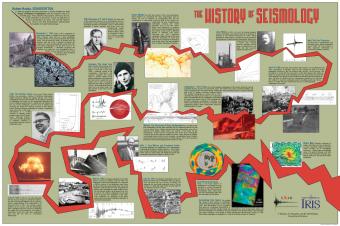Intermediate Spanish

Depicting original sketches, photographs and colorful new imagery, this poster captures the major milestones of the development in the field of seismology. Seismology's rich history begins with Robert Hooke's 1676 paper titled "True Theory of Elasticity or Springness" and continues through the 1830 discovery of P and S waves, the 1930's discovery of the inner core by Inge Lehman, and includes recent innovations such as shake maps, real-time collections of maps depicting shaking intensity within seconds of an earthquake.
Requesting Posters:
To request hardcopies of E&O materials, please send an email to EandOproduct@iris.edu with the following information:
PLEASE NOTE: Time-sensitive requests must be sent at least three weeks beforethe date they are needed. When e-mailing a time-sensitive request, please write "Time-Sensitive Request" in the subject line.

The Earth has 3 main layers based on chemical composition: crust, mantle, and core. Other layers are defined by physical characteristics due to pressure and temperature changes. This animation tells how the layers were discovered, what the layers are, and a bit about how the crust differs from the tectonic (lithospheric) plates, a distinction confused by many.